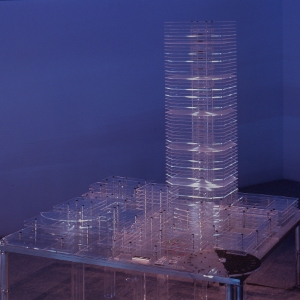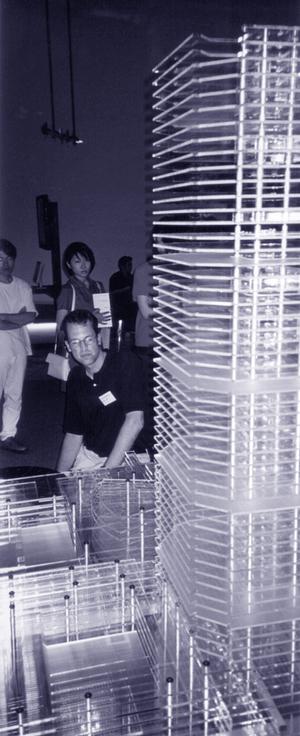

concept
Strata uses multi-layered architectural models as a means for physically embodying digital information relating to specific buildings. In the Strata/ICC case, we have developed a two-meter high, digitally instrumented model of the Tokyo Opera City building (which houses ICC). The model's floors illuminate under digital control to indicate different kinds of building activity, including temperature, network traffic, and electrical load. The intended users are both professional building and computer services staff, as well as building residents and visitors. The installation is intended to provide a compelling platform for viewing, monitoring, interacting with, and discussing building information that is normally invisible and largely inaccessible.history
The Strata project originated with a prototype in 1999 by Brygg Ullmer and James Patten, used as a tool for building and network management at the MIT Media Lab. This version was built around a series of layered flat panel displays. While the flat panel approach supports the display of detailed, high-resolution information, it works less well for peripherally monitoring different kinds of activity. Strata/ICC was conceived partially as a kind of middle-ground between Tangible Media's work with graspable and ambient interaction/display paradigms. Another key concern was an interest in exploring physically larger-scale interfaces for representing and interacting with information.principles of operation
The Strata/ICC interface is embodied by a sixty layer acrylic and aluminum model of the Tokyo Opera City building. Each building floor is represented by a layer of acrylic integrating a networked microcontroller and several white LEDs. These electronics allow each floor to edge-light in different patterns under computer control. The aluminum columns which physically support the model also support the tower's digital infrastructure, channelling power and data through the structure. Physical tokens allow the building's display to be bound to different data channels, and a motorized "time wheel" allows navigation of the last 24 hours of data.significance
Present-day computing devices are developed almost entirely for the mass market, produced in runs of many thousands or millions of units. Strata explores an alternative approach modelled more on the design of architectural building, where the physical form of buildings reflects their specific site, occupant, aesthetic goals, and intended use. In Strata/ICC, our interface is quite literal to this analogy -- literally, an interface to a particular physical building. However, we have also begun implementing interfaces relating to biological research, distributed network management, and other domains that do not have pre-existing physical forms.Strata is also intended to explore and challenge ideas about physical scale in human-computer interaction. Mainstream computing devices are steadily shrinking in size, and even disappearing onto our body and into our clothes. Strata explores computing interfaces of larger physical scale, pushing towards interfaces allowing the display and interaction with information at the physical scale of our bodies, rooms, and even buildings. In the process, we wish to embrace and facilitate interaction between multiple people, computing systems, and our physical environment, with high-quality physical artifacts intended to be used for decades, rather than face obsolescence in months.